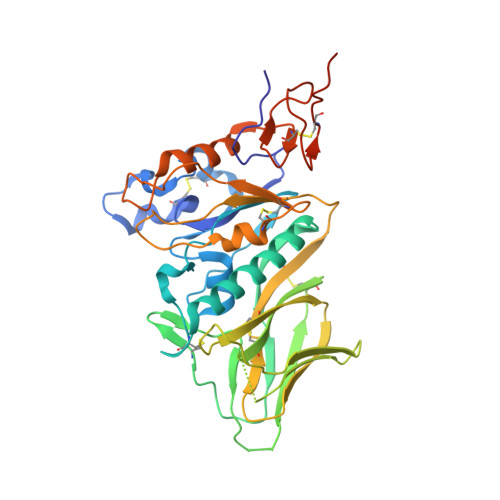Betacoronavirus Adaptation to Humans Involved Progressive Loss of Hemagglutinin-Esterase Lectin Activity.
Bakkers, M.J., Lang, Y., Feitsma, L.J., Hulswit, R.J., de Poot, S.A., van Vliet, A.L., Margine, I., de Groot-Mijnes, J.D., van Kuppeveld, F.J., Langereis, M.A., Huizinga, E.G., de Groot, R.J.(2017) Cell Host Microbe 21: 356-366
- PubMed: 28279346
- DOI: https://doi.org/10.1016/j.chom.2017.02.008
- Primary Citation of Related Structures:
5N11 - PubMed Abstract:
Human beta1-coronavirus (β1CoV) OC43 emerged relatively recently through a single zoonotic introduction. Like related animal β1CoVs, OC43 uses 9-O-acetylated sialic acid as receptor determinant. β1CoV receptor binding is typically controlled by attachment/fusion spike protein S and receptor-binding/receptor-destroying hemagglutinin-esterase protein HE. We show that following OC43's introduction into humans, HE-mediated receptor binding was selected against and ultimately lost through progressive accumulation of mutations in the HE lectin domain. Consequently, virion-associated receptor-destroying activity toward multivalent glycoconjugates was reduced and altered such that some clustered receptor populations are no longer cleaved. Loss of HE lectin function was also observed for another respiratory human coronavirus, HKU1. This thus appears to be an adaptation to the sialoglycome of the human respiratory tract and for replication in human airways. The findings suggest that the dynamics of virion-glycan interactions contribute to host tropism. Our observations are relevant also to other human respiratory viruses of zoonotic origin, particularly influenza A virus.
Organizational Affiliation:
Virology Division, Department of Infectious Diseases and Immunology, Faculty of Veterinary Medicine, Utrecht University, 3584 CH Utrecht, the Netherlands.





















